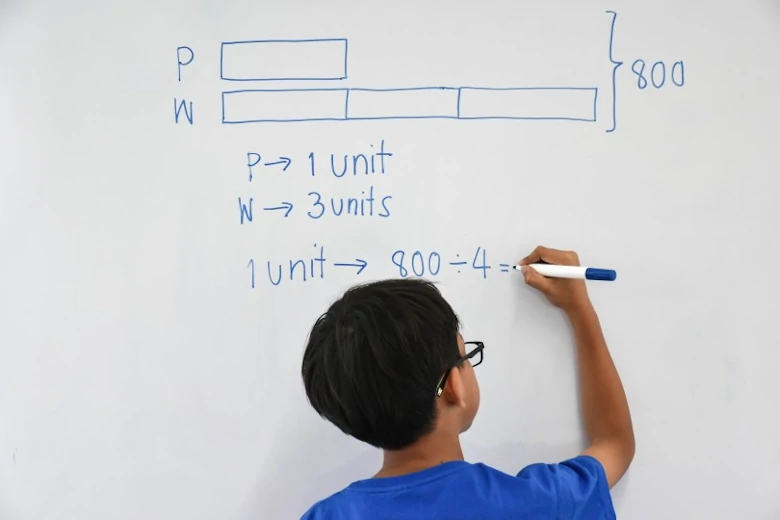Maths Model drawing: Mastering visual problem-solving
- Tags:
- Primary Maths

Welcome to the world of model drawing maths, where complex maths problems are simplified using visuals, making them easier to comprehend and solve.
In this article, we will explore the benefits of the Singapore Maths model method, its applications, and techniques.
Maths Model Drawing: A Powerful Problem Solving Tool
Maths model drawing, also known as bar modelling or strip diagrams, is a revolutionary technique that originates from the Singapore maths curriculum. It involves representing complex problems with visual models, usually using bars or blocks, to better understand and solve them. The approach is not only effective for basic arithmetic but also applicable to more advanced mathematical concepts.
Advantages Of Maths Model Drawing
Model drawing offers numerous benefits that set it apart from traditional problem-solving methods:
1. Enhancing conceptual understanding
Model drawing provides a deeper understanding of mathematical concepts by visualising relationships and proportions between different elements of a problem. It allows learners to see how quantities are related, facilitating better comprehension.
2. Overcoming word problem challenges
Word problems often pose difficulties for students. Model drawing helps in translating word problems into visual representations, making them easier to interpret and solve step by step.
3. Developing logical thinking
Through model drawing, individuals develop essential logical and critical thinking skills. By breaking down problems into smaller, manageable parts, learners can analyse and deduce the most suitable solutions.
4. Building problem-solving confidence
As learners successfully tackle problems using model drawing, their confidence in their mathematical abilities grows. This newfound confidence translates into improved performance and a positive attitude towards maths.
5. Bridging the gap between concrete and abstract
Model drawing acts as a bridge between concrete manipulative and abstract mathematical concepts. This means that this technique enables learners to connect real-world scenarios with mathematical symbols and operations.
Key Techniques Used In Maths Model Drawing
A. Unit bars representation
The fundamental aspect of model drawing involves using unit bars to represent quantities. Each bar length represents a specific quantity, and relationships between bars illustrate the problem's constraints.
B. Part-whole relationships
Model drawing effectively represents part-whole relationships in mathematical problems. By visually dividing bars into segments, learners can grasp proportions and identify missing values.
C. Comparison
Comparing different bars and their lengths allows learners to understand and solve ratio problems with ease. Model drawing provides a clear depiction of relative sizes and helps find missing values. If you'd like to learn how to solve comparison problems using maths models, check out this blog.
D. Multi-step problem solving
Complex problems often require multiple steps to reach a solution. Model drawing breaks down such problems into manageable parts, simplifying the solving process.
How to apply model drawing to mathematical problems?
Step 1: Understand the problem
Read the problem carefully and identify the given information and what needs to be solved. Take note of the units mentioned and the context of the problem.
Step 2: Choose the right model
Select the appropriate model representation for the problem. It could be a single-bar model, a comparison model, or a combination of both.
Step 3: Visualise the information
Draw the model representation based on the given information. Use unit bars to represent the quantities involved and label the different parts of the problem.
Step 4: Analyse and solve
Examine the model and analyse the relationships between the bars. Apply mathematical operations to find the solution step by step.
Step 5: Validate the solution
Check if the solution aligns with the problem's context and if it satisfies all the given conditions. Revise if necessary.
Applications Of Maths Model Drawing
I. Arithmetic operations
Model drawing is particularly useful for addition, subtraction, multiplication, and division problems. It simplifies the computation and ensures accuracy.
II. Fractions and decimals
Visualising fractions and decimals using model drawing helps learners comprehend fractional relationships and decimal operations.
III. Ratio and proportion
Model drawing simplifies complex ratio and proportion problems, making it an invaluable tool in various real-world scenarios.
IV. Algebraic equations
Even algebraic equations can benefit from model drawing, especially when dealing with linear equations or systems of equations.
V. Geometry
Model drawing can aid in visualising geometric concepts, such as area, perimeter, and angles, leading to a more intuitive grasp of geometry.
Frequently Asked Questions (FAQs)
Q: What age group is model drawing suitable for?
Model drawing is applicable to learners of all ages. It is commonly introduced to students around 8-10 years old, but older learners can also benefit from its problem-solving approach.
Q: How can model drawing improve my child's math performance?
Model drawing fosters a deeper understanding of mathematical concepts and builds problem-solving confidence. By visualising and solving problems step by step, your child can excel in math and approach it with enthusiasm.
Q: How long does it take to master model drawing maths?
The time to master model drawing varies from person to person. With consistent practice and guidance, learners can significantly improve their skills within a few weeks to a few months.
Q: Are there any specific model drawing techniques for advanced maths?
Indeed, advanced mathematics, such as calculus and algebraic expressions, may require additional techniques to visualise problems effectively. However, the fundamental principles of model drawing can be adapted to tackle more complex concepts.


 SG
SG  VN
VN 



















